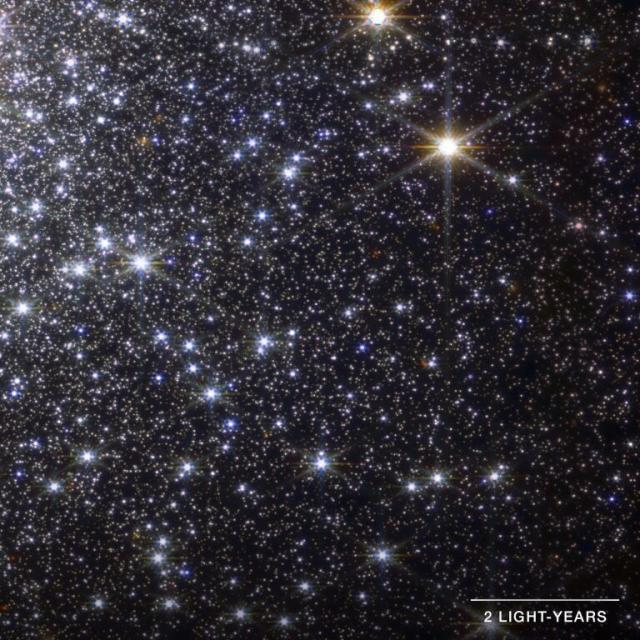If we calculate how many grains are in a teaspoon of sand (an average) & multiply that by the amount of sand estimated on every beach & desert in the world, we get (roughly) seven quintillion, five hundred quadrillion grains of sand on Earth. npr.org/sections/krulwich/2012… #space #science
Meanwhile, there are ~70 thousand million, million, million stars in the observable universe - a figure vastly surpassing all of those grains of sand. The universe is immense, breathtaking & beyond imagination ✨

BoneHo-ho-houseWasps🔶🇬🇧🇪🇺
in reply to Sheril Kirshenbaum • • •Rubik's Cube combinations
Diego de Pereda (Rubik)BigD
in reply to Sheril Kirshenbaum • • •BarbaraPittman ☕️💬
in reply to Sheril Kirshenbaum • • •The Lady Parabellum
in reply to Sheril Kirshenbaum • • •I hate it when we get silly with changing terms.
"70,000 million million million" simplifies to 70 x 10^21
7.5 quintillion is 7.5 x 10^18
So... 10,000 times, +/-
70,000 quintillion vs 7.5 quintillion
It's almost 0300hrs, why am I deobfuscating stuff like this in my head?
Oh, yeah, it annoys me.
Stegasaurus
in reply to Sheril Kirshenbaum • • •Mark McCaughrean
in reply to Sheril Kirshenbaum • • •Purely coincidentally, I was considering this question last night & your number for stars is probably too high.
The current best estimate for the total number of galaxies in the observable universe is 2 x 10^12. But most are much smaller than our Milky Way & have only 100 million stars on average.
That makes 2 x 10^20 stars vs 7.5 x 10^18 grains of sand on Earth.
So yes, more stars than grains of sand, but “only” by a factor of ~25 or so.
(All with big error bars, of course 🙂)
Sheril Kirshenbaum
in reply to Mark McCaughrean • • •@markmccaughrean Thanks. Yes, I was going with the estimates in the linked NPR piece.
Even the lower estimate is still astounding.
Mark McCaughrean
in reply to Sheril Kirshenbaum • • •Thanks, Sheril – it certainly is 🙂
If I’m right, the 2012 NPR piece uses estimates from 2003, so the data have improved since then, mostly through the Hubble Deep Fields & Gaia.
Very spooky though to know that I was pondering this last night & exchanged emails with Chris Conselice, one of the people who have thought about this deeply 😱
James 🦉 #FBPE
in reply to Sheril Kirshenbaum • • •Daniel Pavey
in reply to Sheril Kirshenbaum • • •Sanjay Thakur
in reply to Sheril Kirshenbaum • • •Preston MacDougall
in reply to Sheril Kirshenbaum • • •⬆️ ✅
There are many more atoms in a handful of sand than there are stars ✨ in the (currently) observable universe!
“Chemical Eye 👁️ on Counting our Blessings” 👉 sitnews.us/MacDougall/112805_m…
#chemistry #chemiverse #WilliamBlake #AmadeoAvogadro
SitNews - Chemical Eye on Counting our Blessings by Preston MacDougall
www.sitnews.usDiamond Joy
in reply to Sheril Kirshenbaum • • •James 🦉 #FBPE
in reply to Sheril Kirshenbaum • • •Phil Allsopp
in reply to Sheril Kirshenbaum • • •Brilliant data and wonderful image. I mentioned something similar to this as my wife and I poured 27 Kilo bags of sand into a sink-hole near our water meter.
The Universe is one amazing place and the particles making it and every one of us aren't sub-microscopic bits of "stuff" but persistent disturbances in bizarre 3D quantum fields....
Its a never-ending source of wonder, fascination and deep interest for me...and as for the JWST..what a breathtaking piece of engineering origami!
Ishan
in reply to Sheril Kirshenbaum • • •It’s worse, much worse…
in reply to Sheril Kirshenbaum • • •10tothe22
in reply to Sheril Kirshenbaum • • •Sandra Hoenle (she/her) 🇨🇦
in reply to Sheril Kirshenbaum • • •UK-Birmingham_UTV
in reply to Sheril Kirshenbaum • • •Steve Moore
in reply to Sheril Kirshenbaum • • •Steve Moore
in reply to Sheril Kirshenbaum • • •Charles Eubanks
in reply to Sheril Kirshenbaum • • •AT-AT Assault 🏳️⚧️
in reply to Sheril Kirshenbaum • • •I understand the scales here, but I think its slightly disingenuous to choose different word measures like you did.
"If we calculate how many grains are in a teaspoon of sand (an average) & multiply that by the amount of sand estimated on every beach & desert in the world, we get (roughly) **seven and a half million million million** grains of sand on Earth.
Meanwhile, there are ~70 thousand million, million, million stars in the observable universe"
Now it's easily noticeable there are about 10,000 times more stars than grains of sand.
minhtrung
in reply to Sheril Kirshenbaum • • •Sparkymike
in reply to Sheril Kirshenbaum • • •Laurie S
in reply to Sheril Kirshenbaum • • •davetuikong
in reply to Sheril Kirshenbaum • • •